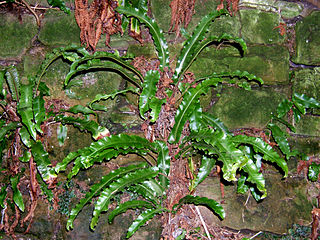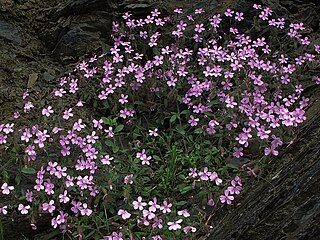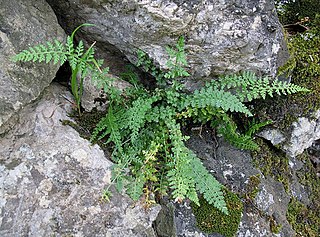
Asplenium scolopendrium, commonly known as the hart's-tongue fern, is an evergreen fern in the genus Asplenium native to the Northern Hemisphere.

The Somali hedgehog is a species of mammal in the family Erinaceidae. It is endemic to Somalia and Somaliland. The Somali hedgehog is nocturnal.
The Ascension wrasse is a species of wrasse native to the eastern Atlantic Ocean, where it is known from St. Helena, Ascension Island, and São Tomé. It inhabits areas of seagrass with rocks at depths from 1 to 30 m. It can reach 10 cm (3.9 in) in standard length. It is one of several fishes commonly called greenfish.

Anogramma ascensionis, the Ascension Island parsley fern, is a species of fern in the family Pteridaceae that is endemic to Ascension Island, a volcanic island in the South Atlantic Ocean. It is one of eight putative species in the genus Anogramma. It was thought to have become extinct due to habitat loss, until four plants were found on the island in 2010. Over 60 specimens were then successfully cultivated at Royal Botanic Gardens, Kew and on Ascension Island. It is now classified as Critically Endangered.
Asplenium aequibasis is a species of fern in the family Aspleniaceae. It is found in Tristan da Cunha. Its natural habitat is subantarctic shrubland.
Asplenium bifrons is a species of fern in the family Aspleniaceae. It is endemic to Ecuador. It is known only from one population in Pichincha Province. Its natural habitat is subtropical or tropical moist montane forests. It is threatened by habitat loss for hydroelectric power.

Hymenasplenium cardiophyllum is a species of fern in the family Aspleniaceae. It is native to China and Japan. Its natural habitat is subtropical or tropical moist lowland forests. It is threatened by habitat loss.
Asplenium congestum is a species of fern in the family Aspleniaceae. It is endemic to Ecuador. Its natural habitats are subtropical or tropical moist lowland forests and subtropical or tropical moist montane forests. It is threatened by habitat loss for agriculture.
Asplenium ecuadorense is a species of fern in the family Aspleniaceae. It is endemic to Ecuador. Its natural habitats are subtropical or tropical moist lowland forests and subtropical or tropical moist montane forests. It is threatened by habitat loss.
Asplenium schweinfurthii is a species of fern in the family Aspleniaceae. It is endemic to Yemen. Its natural habitats are subtropical or tropical dry forests and subtropical or tropical dry shrubland. It is threatened by habitat loss.
Asplenium virens is a species of fern in the family Aspleniaceae. It is endemic to Ecuador, where it is found in coastal forests. This habitat is fragmented and degraded, and habitat loss is the main threat to the species.

Urera kaalae, opuhe, is a species of flowering plant in the nettle family, Urticaceae, that is endemic to the island of Oʻahu in Hawaii. It inhabits slopes and gulches in mesic forests at elevations of 300–760 m (980–2,490 ft). Currently it is restricted to the southern and central parts of the Waiʻanae Mountains. Associated plants include maile, hame, Asplenium kaulfusii, Athyrium spp., ʻāwikiwiki, pāpala, ʻakoko, poʻolā, ēlama, Doryopteris spp., ʻieʻi.e., manono, Hibiscus spp., olopua, māmaki, hala pepe, ʻālaʻa, kōpiko, heuhiuhi, aʻiaʻi, ōpuhe, and maua. It is threatened by habitat loss.
Cyanea procera is a rare species of flowering plant in the bellflower family known by the common name Molokai cyanea. It is endemic to Hawaii, where it is known only from the island of Molokaʻi. It is a federally listed endangered species of the United States. Like other Cyanea it is known as haha in Hawaiian.
Asplenium daghestanicum, the Dagestanian spleenwort, is a species of spleenwort that is endemic to Dagestan in Russia. It is known only from Agulsky and Khivsky districts. It can be found on shaded schist rocks in the middle montane zone, at elevations from 1,800 to 2,300 m. Its population is estimated to be 1,500–2,000 mature individuals. It is threatened by the effects of climate change on its microhabitat.
Asplenium hermannii-christii, Hermann Christ's asplenium, is a species of spleenwort that is endemic to Georgia. It is known from only one location, in the Bzyb River gorge in Abkhazia. It can be found on calcareous rock crevices in the lower montane zone, from elevations of 150–170 m. It is threatened by recreational activities. This species is named after fern botanist Konrad H. Christ.

Petrocoptis pseudoviscosa, commonly known as falguera, is a species of plant in the family Caryophyllaceae. It is endemic to the Spanish province of Huesca, where it is only known from the Valle del Ésera in the Pyrenees. Its natural habitat is calcareous cliffs, crags and caves.

Asplenium fontanum, commonly known as fountain spleenwort or smooth rock spleenwort, is a species of fern in the family Aspleniaceae, native to rocky areas in Western Europe.
Helcogramma ascensionis, the Ascension triplefin, is a species of triplefin blenny in the genus Helcogramma. it was described by Roger Lubbock in 1980. It has been recorded at depths of 0 to 5 metres in tidal pools and rocky reefs around the islands of Saint Helena and Ascension in the south eastern Atlantic Ocean.
Asplenium haughtonii, also known as the Barn fern, is a species of fern in the family Aspleniaceae. It is native to Saint Helena.
Asplenium dielfalcatum is a species of fern in the family Aspleniaceae. It is native to Oahu, Hawaii.







